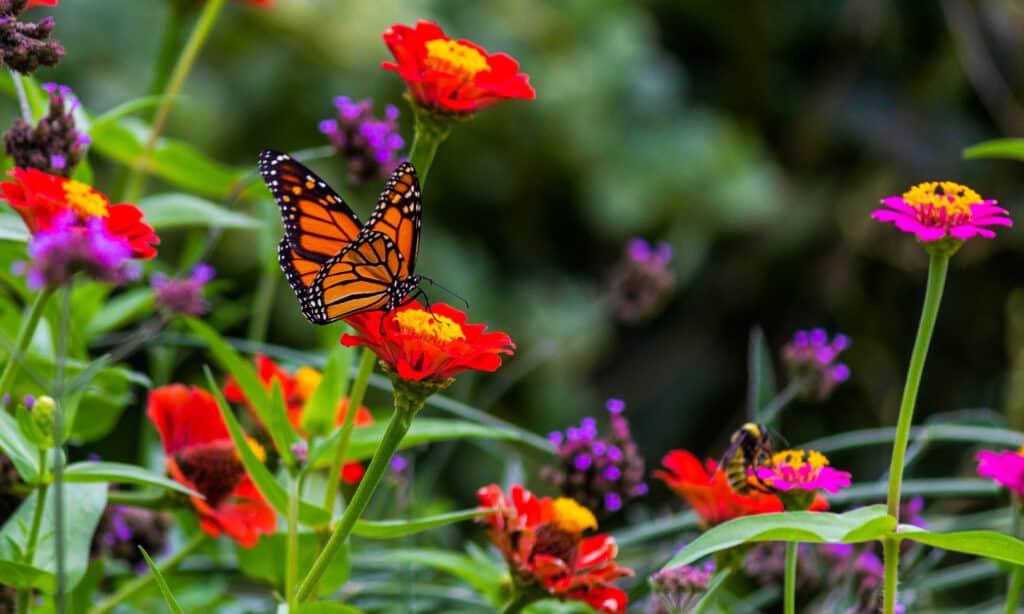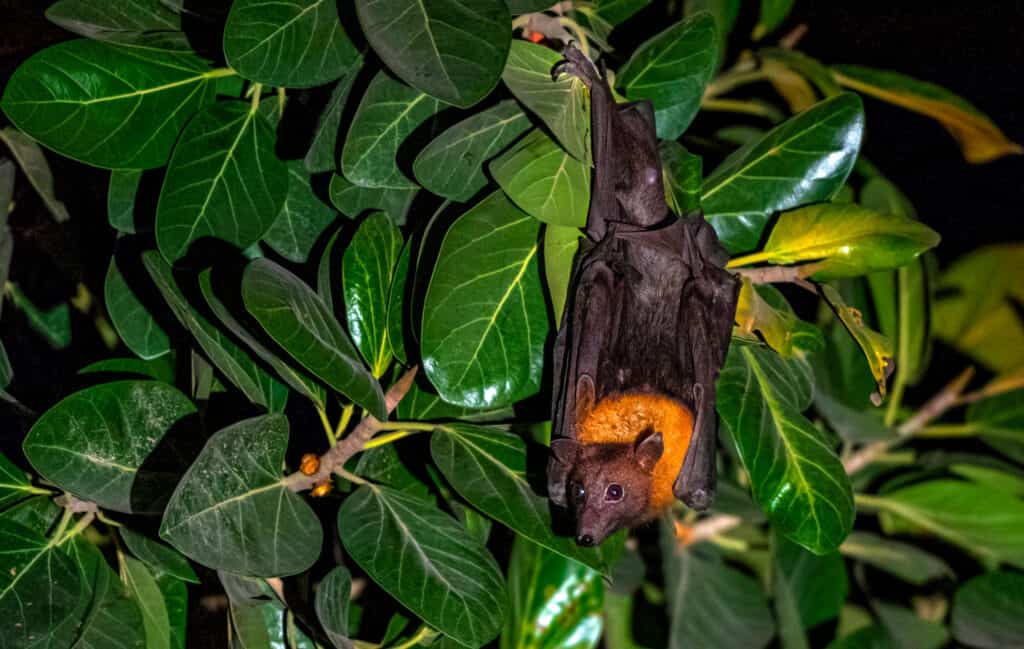Pollination is one of the most fundamental processes to all life on earth. Every living thing relies on it; plants must pollinate to reproduce, and animals rely on plants for food and oxygen. So how does it work? The truth is animals and plants work together and mutually benefit from pollination in many ways. The most popularly known pollinators, bees, are superstars in the pollination game. But what other animals are involved? This article will explore how pollination works and what animals play a part. Here are 4 animals that pollinate, besides bees!
What is Pollination?

Pollination is required for most plants to reproduce.
©Maria T Hoffman/Shutterstock.com
Just as animals must mate to reproduce, pollination must occur for many plants to reproduce. Plants that require pollination include most flowering plants, trees, shrubs, and grasses. In flowering plants (angiosperms) pollen originates on the anther which is the male plant reproductive organ. When pollination occurs, pollen is transferred to a flower’s stigma, the female reproductive component. In some plants, self-fertilization can occur where pollen travels from the anther to the stigma of the same flower. For other plants, pollen must be carried by some environmental medium from one flower to another. This includes traveling by wind, gravity, or by sticking to a pollinator.
Despite common misconception, not all plants have pollen or require pollination to reproduce. The bryophytes, for example, are plant species such as various mosses and liverworts. Rather than producing pollen, they rely on water to carry the male gamete (the reproductive cell that will fuse with the female reproductive cell). Also, ferns and related plants don’t have pollen either. They reproduce using spores.
Why Do Pollinators Pollinate?
Pollinators are animals that transfer pollen from the anther to the stigma of a flower. Many pollinators do this inadvertently when they visit flowers for nectar or fruit. Nectar is a food source for many vertebrate and invertebrate species consisting primarily of water and sugars. If a pollinator lands on a flower to collect nectar, pollen grains will stick to it and when it visits the next flower, it will deposit the pollen from the last flower onto the new one.
With this background knowledge in mind, let’s meet 4 animals that pollinate!
1) Butterflies

Butterflies’ main food source is nectar.
©Kate Scott/Shutterstock.com
The first pollinator we will meet is the butterfly. Did you know there are more than 17,500 species of butterflies alive today? And that’s not including many more extinct butterflies that were alive on earth millions of years ago pollinating ancient plants! Not all butterflies have good relationships with plants, though. While some species are pollinators, many butterfly species are harmful to plants in their larval stages. The ones that are pollinators, however, play an incredibly important role in their ecosystem.
Butterflies are primarily nectarivores which means their main food source is the nectar of flowering plants. When butterflies land on flowers, they use their long proboscis to probe the flower and suck its nectar. As the butterfly enjoys its snack, pollen clings to its legs and abdomen to hitch a ride to the next flower. Scientists have found that butterflies cannot carry as much pollen as bees from flower to flower, but they can carry it for longer distances.
2) Hummingbirds

Hummingbirds are inadvertent pollinators.
©iStock.com/mbolina
The next pollinator we will investigate is the hummingbird! When pollination is facilitated by birds, it is called ornithophily. There are about 361 species of hummingbirds including the smallest bird species in the world- the bee hummingbird! All 361 species facilitate pollination in some way and are therefore critically important to their various habitats. The huge amount of plant diversity in the tropics definitely requires a good number of pollinators!
Hummingbirds, like butterflies, are inadvertent pollinators. They are specially adapted nectarivores with long tongues that can plunge deep into a flower’s nectar reserves. In fact, hummingbirds have semicircular tubes running down their tongues that can efficiently pump nectar in and out. When the hummingbird is slurping down the nectar, pollen sticks to its undercarriage and transfers to the next flower.
3) Lemurs

Lemurs are the main pollinators of traveler’s trees.
©Dirk M. de Boer/Shutterstock.com
Our third interesting, non-bumblebee pollinators are lemurs! Usually, when we think about pollinators we think about bees, then maybe some other insects and some birds. Lemurs are not usually first to mind, yet they are also very important pollinators. There are approximately 111 species of lemurs alive today, but more are still being discovered in the dense rainforests of Madagascar. Lemurs are endemic to the island; this means that they can only be found naturally in the wild in that single place.
Smaller lemur species tend to be omnivores feeding on fruits and insects. Larger species tend to rely more greatly on plant material. Some species feed on nectar and become pollinators inadvertently very similar to the other animals we have met so far. Some Malagasy flower species have evolved lemur-specific attractive traits to encourage the lemurs to feed on the plant and facilitate their pollination. A few major pollinator lemur species are the red-bellied lemur and the ruffed lemur. Some plants that greatly rely on lemurs for pollination include the traveler’s palm (Ravenala madagascariensis) and the legume genus Strongylodon.
4) Bats

Bats are very important pollinators in tropical and desert climates.
©thsulemani/Shutterstock.com
The final cool animal we will examine that pollinates is the bat. Bats are the only mammals capable of true, sustainable flight! That definitely helps them be efficient pollinators! There are about 1,400 species of bats worldwide!
Across the wide variety of bat species is a wide variety of diets. Some bats are omnivores, insectivores, frugivores, or nectarivores. There are even bat species that eat vertebrate animals. The greater spear-nosed bat, for example, feeds on mice, birds, and other bat species! An example of frugivorous bats- ones that have diets primarily of fruit- are the megabats (also known as the fruit bats). The megabats are responsible for seed dispersal and pollination in nearly 188 plant genera! Many other bat species are critical to their ecosystems as pollinators as well. Some tropical plants depend solely on bats to pollinate, reproduce, and survive.
Fun Articles Up Next:
- 15 Best Potted Annual Flowers to Attract Pollinators
- Bee Balm Seeds: How to Grow This Pollinator Favorite
- 7 Plants That Attract Hummingbirds
- Fruit Bat Teeth: Everything You Need to Know
- What do Lemurs Eat? An Island Primate’s Diet
The photo featured at the top of this post is © iStock.com/carolmellema
Thank you for reading! Have some feedback for us? Contact the AZ Animals editorial team.







